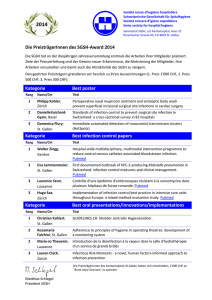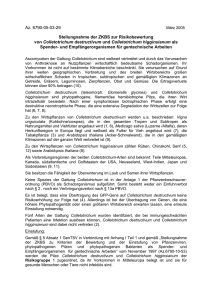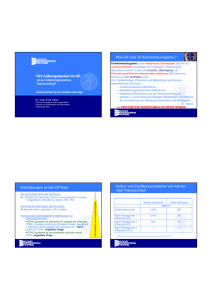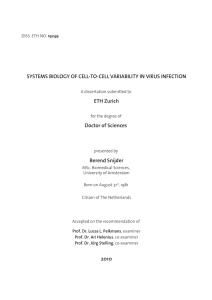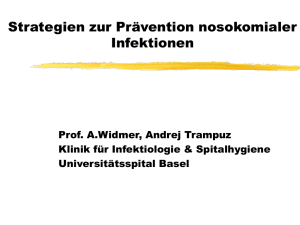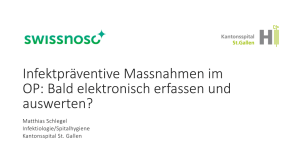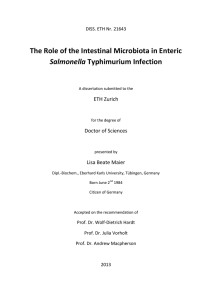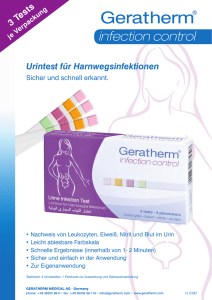Faktoren der Wundheilungsstörungen Assoc.Prof. PD Dr. Oliver
Werbung
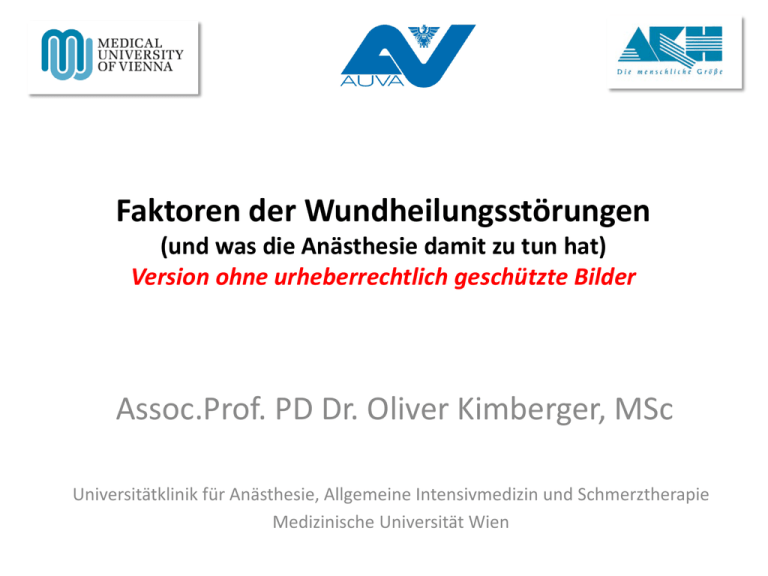
Faktoren der Wundheilungsstörungen (und was die Anästhesie damit zu tun hat) Version ohne urheberrechtlich geschützte Bilder Assoc.Prof. PD Dr. Oliver Kimberger, MSc Universitätklinik für Anästhesie, Allgemeine Intensivmedizin und Schmerztherapie Medizinische Universität Wien Wundheilungsstörung und SSI bei Operationen für Extremitätenverletzungen mit Frakturen • 12 Traumacenter in Frankreich • 1617 Patienten • WHP: 7,00% 6,00% 5,00% 12,00% 8,00% lower limb (n=1342) 3,00% 6,00% total (n=1617) 2,00% 4,00% 1,00% 2,00% 0,00% upper limb (n = 275) 4,00% 10,00% near the skin os (n deep site os (n = Gelenksersatz (n = = 522) 707) 388) WHP (%) SSI (5) 0,00% WHP SSI WHP-> SSI Total SSI Bonnevialle P. Orthopaedics & Traumatology (2012) 98, 684—689 Wundheilungsstörung – Anästhesie? Wundheilungsstörung – Anästhesie? Wundheilung – (Welche Faktoren der Wundheilungsstörung sind bekannt?) – Welche dieser Faktoren kann die Anästhesie wahrscheinlich beeinflussen und wie? Patientenfaktoren • • • • • • • • • • Diabetes Rauchen Schlechter Ernährungszustand Alkoholismus Chron. Nierenversagen Chron. Leberversagen Übergewicht Hohes Alter Schlechter Allgemeinzustand ... Chirurgische Faktoren • • • • • • • • • Ort, Dauer, Komplexität des chirurg. Eingriffs Fremdkörper Fremdmaterial Lokale oder systemische Infektion Hämatom Mechanischer Wundstress Laminar Flow Präoperative Antibiotikaverabreichung ... Anästhesiologische Faktoren – – – – – – – – Temperatur-Management Wärmemethode FiO2 N2O Reduktion von Fremdblutgabe Flüssigkeits-Management Analgesie ... Buggy D. The Lancet 2000, 356: 356 - 257 Gewebssauerstoff <-> Wundinfektion Hopf et al. Wound tissue oxygen tension predicts the risk of wound infection in surgical patients. Arch Surg. 1997 Sep;132(9):997-1004 Infection Rate (%) 45 40 35 30 25 20 15 10 5 0 PsqO2, (mmHg) Hoher FiO2 Greif et al. Supplemental perioperative oxygen to reduce the incidence of surgical-wound infection. N Engl J Med. 2000 Jan 20;342(3):161-7. 80 % oxygen ASEPSIS score Infection (%) 30 % oxygen 0,00 2,00 4,00 6,00 8,00 10,00 12,00 Hoher FiO2 20 18 16 14 12 10 8 6 4 2 0 * infection FiO2 0.35 n= 80 FiO2 0.8 n= 80 hospitalization reop * < 0.05 Pryor et al. Surgical site infection and the routine use of perioperative hyperoxia in a general surgical population: A randomized controlled trial. JAMA. (2004). 291 79–87 Hoher FiO2 – Meta-Analysen • Feb 2012: Togioka et al. The role of perioperative high inspired oxygen therapy in reducing surgical site infection: a meta-analysis. Anesth Analg. 2012 Feb;114(2):334-42. – nur die Subgruppen kolorektale Chirurgie & Vollnarkose zeigten Effekt Hoher FiO2 – Meta-Analysen • Feb 2012: Togioka et al. The role of perioperative high inspired oxygen therapy in reducing surgical site infection: a meta-analysis. Anesth Analg. 2012 Feb;114(2):334-42. – nur die Subgruppen kolorektale Chirurgie & Vollnarkose zeigten Effekt. 7 Studien • Aug 2012: Patel et al. High-concentration oxygen and surgical site infections in abdominal surgery: a meta-analysis. Can J Surg. 2013 Aug;56(4):E82-90. – kein Effekt von erhöhtem FiO2. 6 Studien Hoher FiO2 – Meta-Analysen • Feb 2012: Togioka et al. The role of perioperative high inspired oxygen therapy in reducing surgical site infection: a meta-analysis. Anesth Analg. 2012 Feb;114(2):334-42. – nur die Subgruppen kolorektale Chirurgie & Vollnarkose zeigten Effekt. 7 Studien • Aug 2012: Patel et al. High-concentration oxygen and surgical site infections in abdominal surgery: a meta-analysis. Can J Surg. 2013 Aug;56(4):E82-90. – kein Effekt von erhöhtem FiO2. 6 Studien • Aug 2013: Hovaguimian et al. Effect of intraoperative high inspired oxygen fraction on surgical site infection, postoperative nausea and vomiting, and pulmonary function: systematic review and metaanalysis of randomized controlled trials. Anesthesiology. 2013 Aug;119(2):303-16. „In conclusion, intraoperative high Fio2 may be regarded as a supplemental strategy to further decrease the risk of SSI in patients receiving prophylactic antibiotics.“ 9 Studien Hoher FiO2 Meyhoff et al. Anest Analg. 2012; 115(4): 894-854 Meyhoff et al. Anesthesiology. 2014;120(4):1052-1053. Temperatur-Management Temperatur-Management • Winfree CJ, Baker KZ, Connolly ES Jr. Perioperative normothermia and surgical-wound infection (letter). N Engl J Med 1996;335:749. • Baker KZ, Baker CJ, Desai RD, Jackson T. Craniotomy wound infection is not associated with intraoperative hypothermia (abstract). J Neurosurg Anesthesiol 1995;7:316. • Munn MB, Rouse DJ, Owen J. Intraoperative hypothermia and postcesarean wound infection. Obstet Gynecol 1998;91:582. (18 vs. 18, case control Studie). • Kawaraguchi Y, Kawaguchi M, Inoue S, Sakamoto T, Kitaguchi K, Furuya H, Sakaki T. Effect of deliberate mild hypothermia on the incidence of surgical-wound infection and duration of hospitalization in neurosurgical patients (abstract). Masui 1999;48:232. • Barone JE, Tucker JB, Cecere J, Yoon MY, Reinhard E, Blabey RG, Lowenfels AB. Hypothermia does not result in more complications after colon surgery. Am Surg 1999;65:356. (retrospektive Studie, 101 normotherme vs. 49 hypotherme Patienten) • Maldonado et al., Mild Perioperative Hypothermia and the Risk of Wound Infection. Arch. Med. Res., 2001;227-231 (prospektive Kohortenstudie) • Edwards RK, Madani K, Duff P. Is perioperative hypothermia a risk factor for post-Cesarean infection? Infect Dis Obstet Gynecol. 2003;11(2):75-80. (retrospektive Kohortenstudie) – Fieber –> Infektion • Guest JD, Vanni S, Silbert L. Mild hypothermia, blood loss and complications in elective spinal surgery. Spine J. 2004 Mar-Apr;4(2):130-7. (retrospektive Kohortenstudie): “Lengthy exposure to mild hypothermia appeared to be associated with wound infections.” • Walz JM, Paterson CA, Seligowski JM, Heard SO. Surgical site infection following bowel surgery: a retrospective analysis of 1446 patients. Arch Surg. 2006 Oct;141(10):1014-8; discussion 1018. „The fact that a higher intraoperative temperature nadir was associated with higher incidence of postoperative SSI is surprising“ • Baucom RB, Phillips SE, Ehrenfeld JM, Holzman MD, Nealon WH, Sharp KW, Kaiser JL, Poulose BK. Defining intraoperative hypothermia in ventral hernia repair. J Surg Res. 2014 Jul;190(1):385-90. „Our results demonstrate no association between temperature and SSI in VHR“ • Inaba K, Teixeira PG, Rhee P, Brown C, Salim A, DuBose J, Chan LS, Demetriades D. Mortality impact of hypothermia after cavitary explorations in trauma. World J Surg. 2009 Apr;33(4):864-9. “Hypothermia is an independent predictor of mortality.” • Melton GB, Vogel JD, Swenson BR, Remzi FH, Rothenberger DA, Wick EC. Continuous intraoperative temperature measurement and surgical site infection risk: analysis of anesthesia information system data in 1008 colorectal procedures. Ann Surg. 2013 Oct;258(4):606-12; discussion 612-3. „Although active rewarming remains an accepted and valid process measure, highly granular anesthesia information system temperature data did not demonstrate a correlation between temperature measures and SSI.“ Temperatur-Management • 524 Patienten – „urgent trauma laparotomy“ • Retrospektive Analyse • SSI Rate 36 % (Literatur: 9 – 32 %) • Bester Cutoff: 35 ° C • „Eine einzige intraoperative Messung < 35 °C verdoppelte das Wundinfekt-Risiko“ Seamon M. Annals of Surgery 2012, 255(4): 997-1004 Temperaturmanagement • Verlängerung Medikamentenmetabolismus (Hypnotika, Muskelrelaxantien) • Verlängerung der Aufenthaltsdauer im Aufwachraum und im Krankenhaus (Lenhardt, 1997, Anesthesiology) • Vermehrter Verbrauch von Blutkonserven (Meta-Analyse: Rajagopalan, 2008, Anesthesiology) • Vermehrt myokardiale Komplikationen (Frank, 1997, JAMA) • Kältezittern, erhöhter O2 Verbrauch und PatientenDiskomfort (Rally, 1988, Can.J.Anest.) Gebläse-Wärmen – gut oder böse? = ? Forced-air warming and ultra-clean ventilation do not mix, Mc Govern et al., J Bone Joint Surg., 2011: 93(11) Do forced air warming devices disrupt unidirectional downward airflow?, Legg et al., J Bone Joint Surg., 2012, 94: 254-6 Forced-Air warming does not worsen air quality, Sessler et al., Anest Analg, 2011, 113(6) Convective warming therapy does not increase the risk of wound contamination in the operating room, Zink et al., Anest Analg 1993, 76: 50-3 Bair Hugger in prolonged vascular surgery: an infection risk?, Huang et al., Crit Care, 2003, 7 (3) Do forced air warming devices disrupt unidirectional downward airflow?, Legg et al., J Bone Joint Surg., 2012, 94: 254-6 Forced-Air warming does not worsen air quality, Sessler et al., Anest Analg, 2011, 113(6) Vermeiden von N2O • Rationale: – – • Inaktivierung von Vitamin B12 -> Hemmung der DNA Synthese (Skacel PO et al. Studies on the haemopoetic toxicity of nitrous oxide in man. Br J Haematol 1983; 53: 693–701.) direkte Hemmung der Chemotaxis von Neutrophilen (Kripke BJ et al. Suppression of chemotaxis to corneal inflammation by nitrous oxide. Zhonghua Min Guo Wie Sheng Wu Ji Mian Yi Xue Za Zhi 1987; 20: 302–10.) Fleischmann et al. Nitrous oxide and risk of surgical wound infection: a randomised trial The Lancet 2005; 366: 1101-7. n = 418 Vermeiden von N2O • Rationale: – – • • Inaktivierung von Vitamin B12 -> Hemmung der DNA Synthese (Skacel PO et al. Studies on the haemopoetic toxicity of nitrous oxide in man. Br J Haematol 1983; 53: 693–701.) direkte Hemmung der Chemotaxis von Neutrophilen (Kripke BJ et al. Suppression of chemotaxis to corneal inflammation by nitrous oxide. Zhonghua Min Guo Wie Sheng Wu Ji Mian Yi Xue Za Zhi 1987; 20: 302–10.) Fleischmann et al. Nitrous oxide and risk of surgical wound infection: a randomised trial The Lancet 2005; 366: 1101-7. n = 418 Myles et al. Avoidance of nitrous oxide for patients undergoing major surgery: a randomized controlled trial. Anesthesiology. 2007 Aug;107(2):221-31. n = 2050, aber hoher Fi02 statt N2O! Vermeiden von N2O • • • • Rationale: Inaktivierung von Vitamin B12 -> Hemmung der DNA Synthese (Skacel PO et al. Studies on the haemopoetic toxicity of nitrous oxide in man. Br J Haematol 1983; 53: 693–701.), direkte Hemmung der Chemotaxis von Neutrophilen (Kripke BJ et al. Suppression of chemotaxis to corneal inflammation by nitrous oxide. Zhonghua Min Guo Wie Sheng Wu Ji Mian Yi Xue Za Zhi 1987; 20: 302–10.) Fleischmann et al. Nitrous oxide and risk of surgical wound infection: a randomised trial The Lancet 2005; 366: 1101-7. n = 418 Myles et al. Avoidance of nitrous oxide for patients undergoing major surgery: a randomized controlled trial. Anesthesiology. 2007 Aug;107(2):221-31. n = 2050, hoher FiO2 Turan et al. The association between nitrous oxide and postoperative mortality and morbidity after noncardiac surgery. Anesth Analg. 2013 May;116(5):1026-33. Vermeiden von N2O • • Rationale: Inaktivierung von Vitamin B12 -> Hemmung der DNA Synthese (Skacel PO et al. Studies on the haemopoetic toxicity of nitrous oxide in man. Br J Haematol 1983; 53: 693–701.), direkte Hemmung der Chemotaxis von Neutrophilen (Kripke BJ et al. Suppression of chemotaxis to corneal inflammation by nitrous oxide. Zhonghua Min Guo Wie Sheng Wu Ji Mian Yi Xue Za Zhi 1987; 20: 302–10.) Chen Y et al. Leukocyte DNA damage and wound infection after nitrous oxide administration: a randomized controlled trial. Anesthesiology 2013; 118: 1322–31 Vermeiden von N2O • • • • • • Analgesie Awareness Rasches Erwachen Niedrigerer Narkosegasverbrauch Kosten ... Reduktion von Fremdblutgabe Newman ET et al. J Bone Joint Surg Am. 2014 Feb 19;96(4):279-84. Impact of perioperative allogeneic and autologous blood transfusion on acute wound infection following total knee and total hip arthroplasty. • 50 % alle Patienten mit Gelenksersatz erhalten Blutkonserven, im Mittel 2.6 pro Patient (Spahn DR, Anesthesiology 2010, 113(3): 482-95) Evidenz, daß perioperative Transfusion Morbidität und Mortalität verschlechtert (Bernard et al., J Am Coll Surg, J Am Coll Surg. 2009 May;208(5):931-7, 937.e1-2) Retrospektive Analyse 3352 Patienten mit Bluttransfusion für Knie- oder Hüftgelenksersatz • Outcome: Re-Operation wegen V.a. Infektion • • Risikofaktor OR 95% CI p EK-Gabe 2.85 1.3-6.2 0.009 ASA >2 1.98 0.8-4.5 0.099 Diabetes 1.68 0.7-4.2 0.265 Präop HK 1.05 0.9-1.2 0.270 BMI 1.01 0.9-1.1 0.624 Reduktion von Fremdblutgabe Interdisziplinäre Empfehlung zum Anämiemanagement (Patienten-orientiertes Blutmanagement) der OGARI, Version 1.1, 19.9.2013, Kozek-Langenecker et al. Reduktion von Fremdblutgabe The second Austrian benchmark study for blood use in elective surgery: results and practice change. „The prevalence of anemia was three times higher in patients who received transfusions versus those who did not. However, preoperative anemia was left untreated in the majority of patients.“ Gombotz et al. Transfusion. 2014 Oct;54:2646-57. Liberale Flüssigkeitsgabe • Hypovolämie reduziert Gewebssauerstoff / Gewebssauerstoff kann durch Flüssigkeitsgabe optimiert werden (Arkilic CF, Taguchi A, Sharma N, et al. Supplemental perioperative fluid administration increases tissue oxygen pressure. Surgery 2003;133:49 –55.) • Kabon et al. Supplemental intravenous crystalloid administration does not reduce the risk of surgical wound infection. Anesth Analg. 2005 Nov;101(5):1546-53. large volume ASEPSIS score small volume Infection (%) 0,00 2,00 4,00 6,00 8,00 ASEPSIS Score / Infection (%) 10,00 Fluid optimization - GDT Brammar et al. Cochrane Database Syst Rev. 2013 Sep 11. Perioperative fluid volume optimization following proximal femoral fracture • Sinclair S et al. Intraoperative intravascular volume optimisation and length of hospital stay after repair of proximal femoral fracture: randomised controlled trial. BMJ 1997;315:909–12. raschere Erholung, kürzerer Spitalaufenthalt • Venn R, et al. Randomized controlled trial to investigate influence of the fluid challenge on duration of hospital stay and perioperative morbidity in patients with hip fractures. British Journal of Anaesthesia 2002;88:65–71. raschere Erholung, kürzerer Spitalaufenthalt Fluid optimization - GDT Cecconi et al. Critical Care 2013, 17:209 Clinical review: Goal-directed therapy - what is the evidence in surgical patients? The effect on different risk groups Fluid optimization - GDT Cecconi et al. Critical Care 2013, 17:209 Clinical review: Goal-directed therapy - what is the evidence in surgical patients? The effect on different risk groups Analgesie und Wundheilung • Ozan et al. Postoperative pain and subcutaneous oxygen tension. THE LANCET, Vol 354, July 3, 1999 – n = 30, Knie-ASK, intraartikuläres LA • Broadbent E et al. Psychological stress impairs early wound repair following surgery. Psychosom Med 2003; 65: 865–9. Ebrecht M et al. Perceived stress and cortisol levels predict speed of wound healing in healthy male adults. Psychoneuroendocrinology 2004; 29: 798–809 • Schmerz/Stress und Wundheilungsstörung Zusammenfassung Wesentlich: Präoperatives Risk-Assessment, Optimierung möglich? Normothermie FiO2 bei Risikopatienten erhöhen? Gebläsewärmen? Auf N2O verzichten? Blutsparen Optimierung des Flüssigkeit-Status/GDT Stress-Reduktion, optimale Analgesie Zusammenfassung Wesentlich: Präoperatives Risk-Assessment, Optimierung möglich? Normothermie FiO2 bei Risikopatienten erhöhen? Gebläsewärmen? Auf N2O verzichten? Blutsparen Optimierung des Flüssigkeit-Status/GDT Stress-Reduktion, optimale Analgesie }
